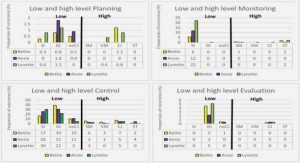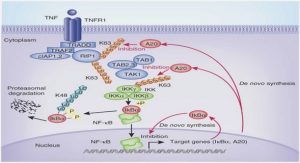Get Complete Project Material File(s) Now! »
INTRODUCTION
This chapter introduces concepts of measurement and verification (M&V) from both M&V practice and research aspects. For the M&V practice, fundamental questions about M&V such as “what is M&V”, “why M&V”, “how to M&V”, and “who are involved in M&V” are answered in Section 1.1.
Then existing M&V research activities are comprehensively reviewed in Section 1.2 in terms of three broad categories, namely, establishment a scientific and formalised M&V framework, development and improvements of M&V techniques, and compiling and sharing global M&V best practice. In Sections 1.3-1.4, the motivation and contribution of this thesis are summarised together with the layout of this thesis.
M&V concept and benefits
M&V is the process of using measurement to accurately and reliably determine the savings delivered by an Energy Conservation Measure (ECM) [1]. The savings can be claimed from any forms of energy, including electricity, gas, oil, and water, etc., while this thesis will focus on electricity savings that usually refer to the absence of energy use or demand. Indeed, there is no direct way to measure energy or demand savings since the absence of energy use or demand is not measurable. However, the savings can be calculated by comparing measured energy use and/or demand from before and after an ECM implementation. Simple comparison by subtraction of post-implementation energy usage from the baseline quantity is not able to differentiate between the energy impacts of the ECM and those of other factors such as weather or occupancy. In order to quantify the impacts of the ECM alone, the influence of other factors, such as weather and occupancy must be eliminated. Therefore, the M&V process to determine savings with measurements involves measuring post-implementation energy usage and comparing that to the measured baseline usage, adjusted or normalised, to act as a proxy for the conditions that would have prevailed had the ECM not been installed.
Existing M&V practices continuously offer valuable feedbacks to the energy efficiency and demand side management (EEDSM) projects from following perspectives [1, 2]:
• The M&V results contribute to better ECM designs and operations, which will ultimately increase energy savings for future EEDSM projects;
• Transparent and credible M&V process reduces the project risk and enhance financing in terms
of both investments and budget managements for EEDSM projects [3];
• The M&V process enhances the value of emission reduction credits and the energy saving
certificates [4, 5];
• M&V helps to quantify the performance of ongoing EEDSM projects and the results can be
used to predict the performance of future EEDSM programmes.
Given the enormous benefits of M&V, it has gradually become an indispensable process in various incentive EE programmes such as clean development mechanism (CDM), tradable white certificate (TWC) scheme, EEDSM programmes, and performance contracting. For instance, the study [6] ex- amines five possibleM&V based approaches for the energy savings evaluation under the international greenhouse gas trading programme. In [5], both the metering approach and the deemed saving approach are introduced for M&V under the TWC scheme. Studies [7, 8, 9] introduce the EEDSM programmes in the European, India and the United States respectively, and they also emphasize that the M&V process offers valuable feedback in improving the programme design. In addition, bothstudies [10, 11] clearly highlight that M&V is the mechanism to ensure that the energy savings are indeed achievable and thus becomes an important function of performance contracting.
Guidance on M&V principles
The best M&V practices are conducted with the guidance of various M&V guidelines, protocols and standards at state, regional, national and international levels. A number of M&V guidance documents are briefly summarised in [12, 13] in terms of the purpose, scope, and intended audience of the existing M&V guidance. In this section, an in-depth review and analysis of different M&V guidance documents based on [12, 13] are provided in order to add clarifications on “how M&V is performed” under different EEDSM programmes in various countries.
Originating in the USA, the international performance measurement and verification protocol (IP-MVP) has evolved into a worldwide standard for M&V and is used in more than forty countries [1]. Clear definitions of terminologies and heavy emphasis on consistent, transparent methods are the core precepts of the IPMVP. It also offers best-practice methods for measuring and verifying the results of ECMs including fuel saving measures, load shifting and energy reductions through in- stallation or retrofit of equipment, and/or modification of operating procedures, water efficiency, and renewable-energy projects in both private and public facilities. Moreover, the IPMVP has established a systematic M&V framework, in which four different M&V methodologies namely, Option A: retro-fit isolation (key parameter measurement); Option B: retrofit isolation (all parameter measurement);
Option C: whole facility measurement; and Option D: calibrated simulation are presented to accom- modate energy conservation projects with different characteristics. The IPMVP’s flexible framework of options allows M&V practitioners to craft the appropriate M&V plan for each situation and instill confidence in those hoping to reap the benefits of the project being evaluated. The details may differ from project to project, but the options and methods presented in the IPMVP have been successfully implemented in thousand of projects and programs in dozens of countries. For example, [14] uses the IPMVP guideline to perform a preliminary assessment for the Louisiana Home Energy Rebate Offer project while [15] presents the IPMVP application and the results of four different calculation options applied to an existing building equipped with an innovative HVAC device in France. The four M&V options enable the user flexibility of savings assessment in terms of both cost and methodologies. A particular M&V option is chosen based on the expectations for EE project performance uncertainties and other project specific features. The options are different, but none of the options is necessarily more expensive or more accurate than the others. Each has advantages and disadvantages based on site specific factors, and the customers’ needs and expectations. The IPMVP has been proven effective in addressing the baseline establishment and savings verification issues for various energy conservation projects over the past 20 years [16].
M&V participants and their relationships
As summarised in the IPMVP, M&V participants are coming from broad areas including energy performance contractors and their clients, new building designers, utility DSM programme designers, emission reduction trading programme designers, and voluntary energy users, etc. In various incentive EEDSM programmes, the aforementioned participant in the M&V process can be classified into four parties namely, project sponsors, ESCo, end users, and M&V body [2]. More precisely, as introduced in [33], “project sponsors” refer to a bank or utility that funds the EEDSMprogramme,“ESCo” means companies that provide EE or load reduction services to customers that own or operate facilities such as buildings or factories; “end users” are the groups and individuals who purchase electricity for their private use; and “M&V body” is responsible for monitoring and verification of the energy and demand reduction achieved by EEDSM projects.
M&V is a standard process to impartially quantify the savings for all DSM project participants. Fig- ure 1.1 shows an interactive relationship between the principal project participants and the M&V body. It is observed that the M&V body is interactive with different project participants but stands apart from the programme environment in order to ensure its independence and impartiality. The purpose of M&V is thus to facilitate agreement between the project participants on the project out- comes.
Abstract
Acknowledgements
CHAPTER 1 : Introduction
1.1 Background
1.1.1 M&V concept and benefits
1.1.2 Guidance on M&V principles
1.1.3 M&V participants and their relationships
1.2 Literature review on measurement and verification
1.3 M&V research problem identification and motivation
1.3.1 M&V research problem identification
1.3.2 Motivation and objectives
1.4 Research contribution and layout of thesis
CHAPTER 2 : Preliminaries
2.1 Chapter overview
2.2 Measurement and Verification
2.2.1 What is M&V?
2.2.2 Measurement boundary and IPMVP options
2.2.3 M&V plan and metering plan
2.2.4 Concepts of M&V savings
2.3 M&V uncertainties and M&V reporting
2.3.1 M&V uncertainties
2.3.2 M&V reporting
2.4 Sampling techniques
2.4.1 Basic statistics
2.4.2 Sampling strategies
2.4.3 Sample size determinations
CHAPTER 3: Measurement and verification practice on lighting
3.1 Chapter overview
3.2 Energy efficiency and management on lighting
3.3 General M&V process for energy efficiency lighting projects
3.4 Lighting baseline and savings determination methodologies
3.4.1 Baseline and savings determination by Options A & B
3.4.2 Savings determination by Option D
3.5 Findings on lighting peak demand diversity factor
3.6 Scope of M&V metering plan
CHAPTER 4: Spatial metering cost minimisation
4.1 Chapter overview
4.2 Introduction
4.3 Model formulation
4.3.1 Modelling assumptions
4.3.2 Spatial metering cost minimisation model
4.3.3 Case study
4.3.4 Base case
4.3.5 Optimal solution
4.4 Model analysis and discussion
4.4.1 Optimal metering cost versus population sizes
4.4.2 Optimal metering cost versus CV values
4.4.3 Optimal metering cost versus individual meter cost
4.4.4 Remarks on the simulations
4.5 Conclusion
CHAPTER 5: Longitudinal metering cost minimisation
5.1 Chapter overview
5.2 Introduction
5.3 Lamp population decay modelling
5.4 Assumptions and modelling
5.5 Case study: model application to a CDM lighting project
5.5.1 Backgrounds of a CDM lighting project
5.5.2 M&V plan
5.6 Optimal solution to the case study
5.6.1 Initial values for the model
5.6.2 Benchmark
5.6.3 Optimal solution
5.6.4 Model application and discussion
5.7 Conclusion
CHAPTER 6: Optimal metering plan for measurement and verification
6.1 Chapter overview and introduction
6.2 Formulation of the optimal M&V metering plan problem
6.2.1 Lamp population decay modelling
6.2.2 Modelling and assumptions
6.3 Case study
6.3.1 Background of the lighting projects
6.3.2 Benchmark
6.3.3 Optimal solutions
6.4 Model application and discussion
6.5 Conclusion
CHAPTER 7: Optimal lighting project maintenance planning
7.1 Chapter overview and introduction
7.2 Problem formulation
7.2.1 Maintenance policy for lighting projects
7.2.2 OMP problem formulation under control system framework
7.2.3 Lighting population decay dynamics modelling
7.2.4 Control objective and constraints
7.3 MPC algorithm to the OMP problem
7.4 Case study
7.5 Simulations on model applications
7.5.1 Model performance versus rebate tariff
7.5.2 Model performance versus unit retrofit price
7.5.3 Model performance versus lighting life span
7.6 Remarks and future work
CHAPTER 8 : Integrated optimal M&V metering and maintenance Plans
8.1 Chapter overview
8.2 Introduction
8.3 Problem formulation
8.4 Case study
8.5 Model application and discussion
8.6 Conclusion
CHAPTER 9: Conclusion and future work
9.1 Conclusion
9.2 Future work




